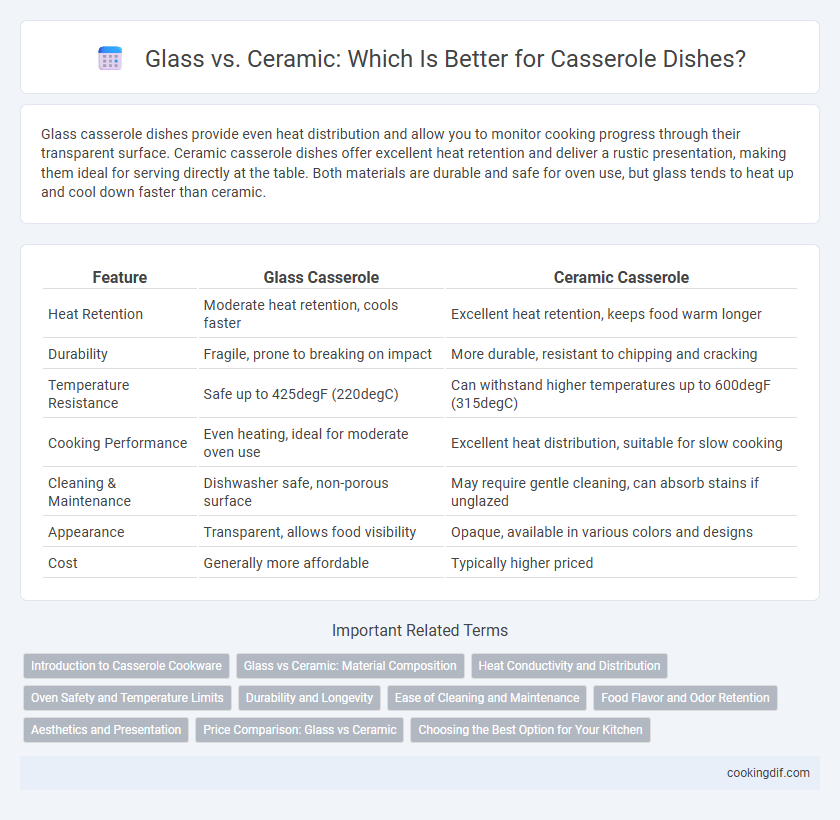Glass casserole dishes provide even heat distribution and allow you to monitor cooking progress through their transparent surface. Ceramic casserole dishes offer excellent heat retention and deliver a rustic presentation, making them ideal for serving directly at the table. Both materials are durable and safe for oven use, but glass tends to heat up and cool down faster than ceramic.
Table of Comparison
| Feature | Glass Casserole | Ceramic Casserole |
|---|---|---|
| Heat Retention | Moderate heat retention, cools faster | Excellent heat retention, keeps food warm longer |
| Durability | Fragile, prone to breaking on impact | More durable, resistant to chipping and cracking |
| Temperature Resistance | Safe up to 425degF (220degC) | Can withstand higher temperatures up to 600degF (315degC) |
| Cooking Performance | Even heating, ideal for moderate oven use | Excellent heat distribution, suitable for slow cooking |
| Cleaning & Maintenance | Dishwasher safe, non-porous surface | May require gentle cleaning, can absorb stains if unglazed |
| Appearance | Transparent, allows food visibility | Opaque, available in various colors and designs |
| Cost | Generally more affordable | Typically higher priced |
Introduction to Casserole Cookware
Glass and ceramic casserole dishes both offer excellent heat retention and even cooking, essential for baking casseroles to perfection. Glass cookware allows for easy monitoring of food without removing lids due to its transparency, while ceramic provides superior insulating properties that keep dishes warm longer after baking. Choosing between glass and ceramic depends on durability needs and aesthetic preferences, as ceramic tends to be heavier and more decorative, whereas glass is lightweight and versatile for stovetop to oven use.
Glass vs Ceramic: Material Composition
Glass casserole dishes are made from tempered soda-lime or borosilicate glass, offering non-porous surfaces that resist staining and do not react with acidic ingredients. Ceramic casseroles consist of natural clay mixed with minerals and fired at high temperatures, creating a porous surface that retains heat evenly and enhances flavor development. Both materials provide durability, but glass offers greater resistance to thermal shock, while ceramic excels in heat retention and aesthetic appeal.
Heat Conductivity and Distribution
Glass casserole dishes offer moderate heat conductivity with even distribution, ideal for slow and consistent cooking. Ceramic dishes excel in retaining heat longer and providing uniform heat distribution, which ensures thorough cooking and keeps food warm after removing from the oven. Choosing between glass and ceramic depends on the desired cooking time and temperature control for your casserole recipes.
Oven Safety and Temperature Limits
Glass casserole dishes offer excellent oven safety with typical temperature limits around 425degF to 450degF, providing consistent heat distribution and resistance to thermal shock when properly preheated. Ceramic casserole dishes can withstand higher temperatures, often up to 500degF or more, making them suitable for recipes requiring intense baking or broiling, but they may be more prone to cracking under rapid temperature changes. Choosing between glass and ceramic depends on cooking temperature requirements and the importance of durability under thermal stress in the oven.
Durability and Longevity
Glass casserole dishes offer excellent heat resistance and non-reactive surfaces, making them durable for regular use but prone to chipping or cracking under sudden temperature changes. Ceramic casserole dishes provide superior longevity due to their thicker, more robust materials that withstand high temperatures and resist scratches, though they may be heavier and more fragile if dropped. Both materials maintain food quality well, but ceramic often outlasts glass in terms of overall durability with proper care.
Ease of Cleaning and Maintenance
Glass casserole dishes offer non-porous surfaces that resist staining and odors, making them easier to clean and maintain after multiple uses. Ceramic dishes, while often more decorative, can be prone to absorbing oils and food residues, requiring more careful cleaning to prevent discoloration. Both materials are generally dishwasher safe, but glass provides a smoother surface less likely to harbor baked-on food, reducing scrubbing effort.
Food Flavor and Odor Retention
Glass casserole dishes are non-porous and do not absorb odors or flavors, ensuring the food retains its original taste without any unwanted aftertastes. Ceramic casserole dishes can sometimes absorb and retain flavors or odors from previous meals, especially if they are unglazed or have micro-cracks. For dishes where preserving pure food flavor is essential, glass casseroles offer superior odor resistance and neutrality.
Aesthetics and Presentation
Glass casserole dishes offer a sleek, transparent look that allows colorful layers of ingredients to be beautifully displayed, enhancing the visual appeal of any meal. Ceramic dishes provide a more rustic and elegant appearance with a variety of glaze finishes and colors, making them ideal for serving directly at the table. Both materials contribute distinct aesthetic qualities, with glass emphasizing modern clarity and ceramic delivering warmth and style in presentation.
Price Comparison: Glass vs Ceramic
Glass casserole dishes typically cost less than ceramic ones, making them a budget-friendly option for everyday cooking. Ceramic casserole dishes often have higher prices due to their durability, heat retention, and aesthetic appeal. Choosing between glass and ceramic casseroles depends on balancing cost with cooking performance and design preferences.
Choosing the Best Option for Your Kitchen
Glass casserole dishes offer excellent heat retention and allow you to monitor cooking progress without lifting the lid, making them ideal for evenly baked meals. Ceramic dishes provide superior heat distribution and add aesthetic value with various colors and designs, perfect for both cooking and serving. Consider your cooking style and presentation preferences; glass is practical for precise baking, while ceramic excels in heat consistency and visual appeal.
Glass vs ceramic for casserole dishes Infographic

 cookingdif.com
cookingdif.com